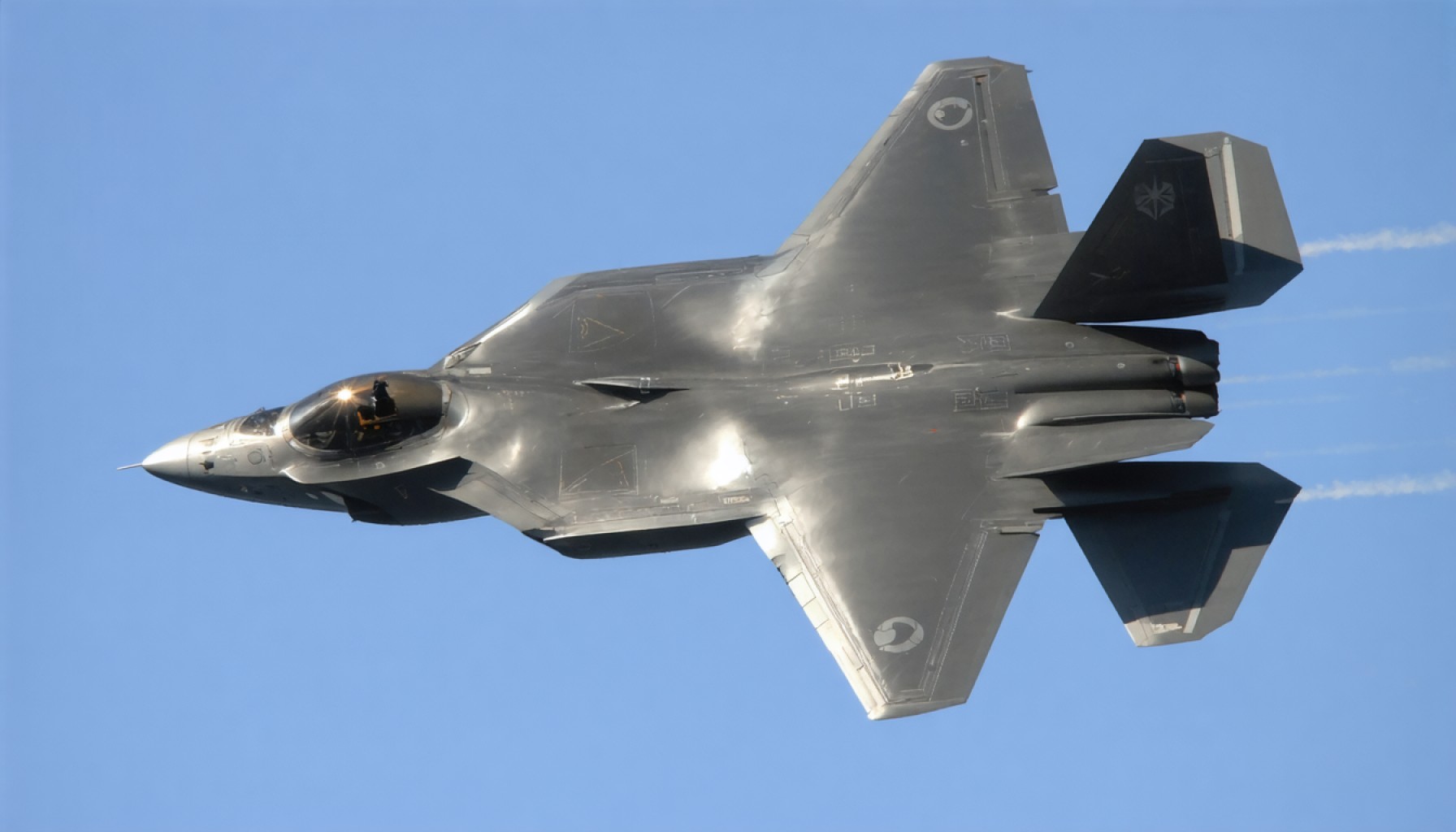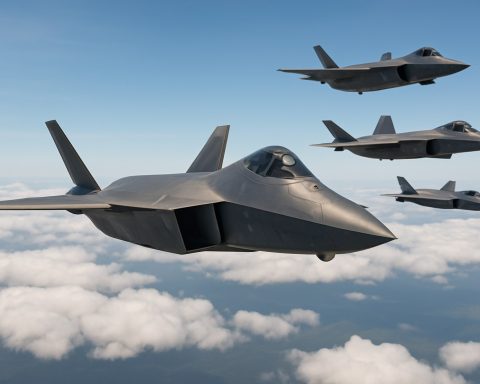- Germany leads the charge with the F-35 Lightning II, strengthening NATO’s air defense with advanced stealth technology.
- Germany’s commitment is evident with a new assembly line in Weeze, producing F-35 fuselages for its Luftwaffe and European allies.
- By 2027, the F-35 will be operational at Büchel Air Base, reinforcing Germany’s military capabilities.
- The F-35 remains unmatched as fourth-generation alternatives don’t compare, with urgency to replace outdated Panavia Tornados by 2030.
- Turkey’s potential return to the F-35 program depends on sidelining its Russian S-400, highlighting geopolitical complexities.
- The F-35 symbolizes more than aviation prowess; it represents intricate alliances and geopolitical influence.
A sleek silhouette, the F-35 Lightning II, soars with the promise of power and precision, captivating not just aviation aficionados but entire nations. As NATO navigates challenging waters, a few members remain steadfast in their embrace of this fifth-generation marvel. Germany emerges as a determined captain, steering its fleet toward a future defined by the cutting edge of stealth technology.
While whispers of dissent ripple through allies such as Canada and Portugal, Germany stands firm. This commitment took tangible form in 2022, when Germany took its bond with the F-35 from paper to production. The decision to erect a new assembly line in Weeze highlights the German tenacity for innovation. Operated by Rheinmetall, this facility will craft the core structure of the F-35 for Germany’s Luftwaffe and other European allies. By 2023, it will have set its mark on no less than 400 fuselages, each a testament to German industry and resolve.
The first of these beasts took form in December, poised to unfurl its wings in 2026 for the Luftwaffe’s inaugural classes of pilots and technicians. Come 2027, the Thunderbolt will nestle at Büchel Air Base, ready to embed itself into Germany’s defensive fabric. As Berlin kicks the dust from rumors of potential U.S. control hiccups, the message is clear: Berlin’s aerospace dream is alive and well.
Europe finds itself at an inflection point. Alternatives to the F-35 exist in name only, with their fourth-generation brethren falling short on capability. The urgency to replace aging Panavia Tornados by 2030 adds to the F-35’s allure—a fighter not just of the skies but of geopolitical might.
This pivot aligns with aspirations of the Future Combat Air System (FCAS), a Franco-German-Spanish endeavor to leapfrog into sixth-generation skies. The winds of change, however, are not exclusive to Western Europe.
Over the horizon, Turkey’s story intertwines with the F-35 narrative once again. Having been ousted from the program for dalliances with Russia’s S-400, negotiations hint at a fascinating plot twist. Making the S-400 inoperable—perhaps by relocating it to a U.S. base—keeps the door ajar for re-entry into the F-35 fold. As Turkey treads this diplomatic tightrope, the complex dance of allegiance reveals a broader theme: the balance of military might and geopolitical power.
The story of the F-35 transcends mere machinery; it’s about alliances and influence, trust and trepidation. As Germany and potentially Turkey weave their futures with this aircraft, they showcase both bold ambition and strategic necessity. The skies over NATO remain ever more intriguing, reminding us that air supremacy is as much about political maneuvering as it is about advanced avionics.
Why the F-35 Stealth Fighter is Reshaping Global Military Strategy
The F-35 Lightning II: A Revolutionary Leap in Military Aviation
The F-35 Lightning II represents a significant advance in military aviation technology. As a fifth-generation fighter, it brings several groundbreaking features to the table:
1. Stealth Capabilities: The F-35 boasts advanced stealth features that significantly reduce its radar cross-section, making it difficult for enemy radars to detect and track.
2. Advanced Avionics: The aircraft is equipped with sophisticated avionics that provide unmatched situational awareness. Its Distributed Aperture System (DAS) offers 360-degree coverage, enabling pilots to detect and respond to threats from all directions.
3. Versatility and Multi-Role Capability: The F-35 can perform a variety of missions, including air dominance, close air support, electronic warfare, intelligence, surveillance, and reconnaissance.
4. Networking and Sensor Fusion: The F-35 acts as a force multiplier with its ability to share data in real-time with other aircraft, ground forces, and command centers.
5. Supersonic Speed and Agility: Its advanced design allows it to perform maneuvers at supersonic speeds, enhancing its effectiveness in combat scenarios.
Germany’s Strategic Commitment to the F-35
Germany’s decision to invest in the F-35 came amidst critical geopolitical shifts. By establishing a new assembly line operated by Rheinmetall in Weeze, Germany is demonstrating its commitment to both innovation and NATO’s strategic objectives. Here’s why this is significant:
– Replacing Aging Fleets: With its investment, Germany aims to replace its aging Panavia Tornados by 2030, ensuring fleet readiness and enhanced national defense capabilities.
– Economic and Industrial Growth: The new production facility is expected to boost local economies and provide technological advancement opportunities.
– Strategic Sovereignty: By pushing back against concerns over U.S. control, Germany is asserting its aerospace sovereignty and independence in military technology.
The Role of NATO and Future Combat Systems
Germany’s embrace of the F-35 aligns with other strategic NATO initiatives, such as the Future Combat Air System (FCAS). This tripartite project between France, Germany, and Spain aims to launch a sixth-generation fighter by the 2040s. The FCAS initiative is focused on:
– Enhanced Collaboration: Strengthening EU military collaboration and reducing reliance on non-European systems.
– Technology Advancement: Leveraging emerging technologies like artificial intelligence and autonomous systems.
The Turkish Puzzle: Re-Entry into the F-35 Program
Turkey’s potential re-entry into the F-35 program underscores the complicated dynamics of international military alliances. Here’s the latest:
– S-400 Controversy: Turkey was previously ousted due to its purchase of Russian S-400 missile systems. Diplomatic efforts are underway to resolve this, such as making the S-400 inoperable.
– Geopolitical Balance: How Turkey navigates this path could realign its relations with NATO and influence its regional power status.
Pressing Questions and Insights
Why is the F-35 preferred over fourth-generation fighters?
The F-35’s advanced stealth, superior sensor capabilities, and robust communication systems make it unmatched by any fourth-generation aircraft, which cannot offer the same level of threat engagement and avoidance.
How does the F-35 support global security?
By enabling covert operations and networked warfare, the F-35 plays a critical role in maintaining air superiority vital for global peacekeeping operations and deterrence.
What is the cost of the F-35?
The estimated cost of a single F-35 is around $80 million, but total program costs, which include maintenance and updates, are significantly higher.
Actionable Tips for Military Enthusiasts and Policymakers
– Stay Informed: Follow credible military analysis for insights into ongoing geopolitical shifts related to the F-35.
– Engage in Dialogue: Discussions on platforms like defense forums and conferences can provide deeper understanding and networking opportunities.
– Monitor Industry Trends: Keep an eye on emerging technologies in aviation that could complement or challenge the F-35’s capabilities.
For more information, consider visiting Lockheed Martin, the primary contractor for the F-35 program, to access deeper insights into this aircraft’s technical specifications and roles in modern warfare.







